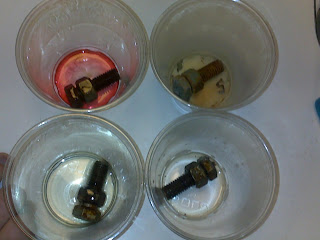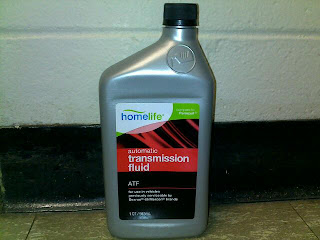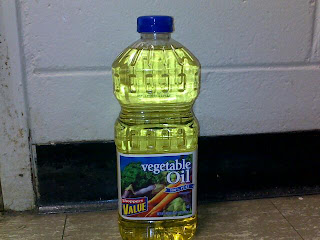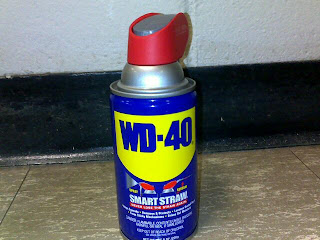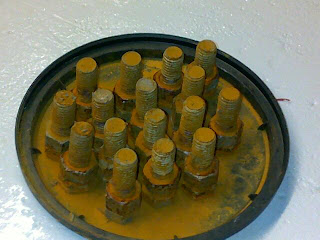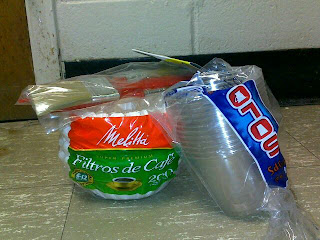The group conducted the experiment this week on the various types of penetrating oil. They produced the oils using different percentage mixtures of vegetable oil, acetone ATF, and compared them to WD-40. The experiment was performed successfully and the results were within the expected parameters with acetone demonstrating its superiority. The link below is the document that contains our results in a detailed experimental report and the image below is of the rusted bolts after they have been allowed to soak in the penetrating oil mixtures for twelve hours to show their rust repelant abilities.
http://word.office.live.com/wv/WordView.aspx?FBsrc=http%3A%2F%2Fwww.facebook.com%2Fdownload%2Ffile_preview.php%3Fid%3D233024796807512%26metadata&access_token=100001745781359%3AAVIdjzqDdlIF5cXhQmEQRNydajLuRmeio7599ht5MBiPUw&title=WD-40+Testing+results.docx
Group 046-03: Penetrating Oil (WD-40) Alternative
Friday, June 1, 2012
Week #7: Gathering Materials
This week the group spent time and money to procure the materials that would be needed for the experiments. The various materials shown below are transmission oil, a vicegrip, a torquewrench, a filtercup brush, vegetable oil, WD-40, and some bolts that have already been rusted.
Friday, May 11, 2012
Week #6: Initial Experiment Materials and Procedure
The team has developed an initial outline for the experiment which they will begin using in their research to develop a penetrating oil. The material used are: 12 same sized bolts, sulfuric acid, a vice grip, a torque wrench, WD-40, and two other brands of penetrating oil. These materials will be used to determine the force needed to free the rusted bolts and how WD-40 and the other penetrating oils are able to meet this demand. The procedure for the experiment will be to place the bolts in sulfuric acid for a few days to stimulate corrosion between the nut and bolt. The bolts will then be removed from the acid and cleaned. A bolt will be placed inside a vice grip, which will hold the bolt in place, and sprayed with WD-40. The torque wrench will then determine the force needed to remove the nut from the bolt, and this will be repeated with the other two penetrating oils. The data that will be collected will be used to determine how effective the oils are, in order to compare it and help with the design for the penetrating oil that the team produces.
Week #4-5: Stakeholders and Design Goal Expanded
The team has reevaluated the aspects of this project, such as their stakeholders and the main project goal. It has been determined that the direct stakeholders will be a series of groups consisting of the community, design team, hardware stores, environment, manufacturers and machinists. The community has a demand for the newly developed penetrating oil, which must be created by the design team. Since the project is mainly being considered for Africa, the places that will sell this product are the hardware stores. Based on the created product’s cost effectiveness, the manufacturers will have to mass-produce the penetrating oil that will be sold at these stores. The machinist who will be using the product in Africa have to be able to use the product in a simple manor and understand it’s proper use and any dangers that might be involved while handling it. Lastly the environment must be considered. The product should be more or less environmentally safe so that the product will put little to no stress on the environment in the areas that use and dispose of the penetrating oil.
The team has also come-up with the single most important aspect of the penetrating oil’s design, lubrication. The lubrication of the oil determines how well it can penetrate the rust between metals and fasteners, so that they may be separated. The overall effectiveness of the designed oil’s ability to lubricate while being cost-effective and meeting the demands of the stakeholders will determine how successful the group’s design truly is.
Friday, April 20, 2012
Week #3: Group Ideas
The needs for a penetrating oil alternative are in high demand for developing nations, such as the various nations in Africa. Apparently, many nations in Africa use kerosene as a form of penetrating oil. Unfortunately, kerosene in not in abundance and can be costly. The main goal the team has come up with is to find a way to produce a cheaper penetrating oil that greatly outperforms kerosene.
After analysis of the project needs for developing nations, the team has come up with some initial designs. The main design considered is a mixture of transmission oil, acetone, and paraffin. Acetone and transmission oil produce a powerful penetrating oil, but the reaction between them can be somewhat unstable, this problem is solved by adding paraffin to the mixture. Another possibility the group has come up with is to use the same mixture above, but replacing transmission oil with vegetable oil. This may produce a good penetrating oil that can be environmentally safer and might support the current “green” movement. Overall the team plans to test various amounts of the above mixtures and test them on rusted fasteners to see if they can develop a useful penetrating oil.
Friday, April 13, 2012
Week #2: Initial Research and Basic Info
What is penetrating oil, such as WD-40, and what is its purpose?
Penetrating oil is a type of substance used to prevent the formation of rust or sever the bondage the rust has formed between two metals. It is usually associated with smaller metallic parts, such as nuts and bolts. Penetrating oil can also have various scattered uses based on the type, such as being a lubricant or cleaning agent.
Penetrating oil, also known as penetrating fluid, attains its "penetrating" ability through its components and its unique properties. The oil is said to be low-viscosity, which is essentially the "thickness" or "fluidity" of the liquid. The primary components of these substances are usually a mixture between a solvent and an oil. A solvent is a compound that can have any physical state of matter that dissolves a solute, which is any compound that can be dissolved. The oil can also sometimes contain a fuel based gas that may be incorporated with small amounts of other components.
There are many types of penetrating oils other than WD-40, and each has its own benefits. WD-40 is just considered to be the most versatile of the oils, because it has so many uses that it's known as a magical "cure-all" for anything that is broken. The downside is that WD-40's penetrating abilities can be somewhat weaker than others. Stronger types of penetrating oils were produced to be used on older, more corroded objects. One common type is formed between mixing equal amounts of the solvent acetone with automatic transmission fluid. This resulting mixture is dangerous to use without protection, but it can many times more effective than WD-40. Many cheaper alternatives are available for penetrating oil, but they can prove to be more dangerous than beneficial.
Penetrating oil is a type of substance used to prevent the formation of rust or sever the bondage the rust has formed between two metals. It is usually associated with smaller metallic parts, such as nuts and bolts. Penetrating oil can also have various scattered uses based on the type, such as being a lubricant or cleaning agent.
Penetrating oil, also known as penetrating fluid, attains its "penetrating" ability through its components and its unique properties. The oil is said to be low-viscosity, which is essentially the "thickness" or "fluidity" of the liquid. The primary components of these substances are usually a mixture between a solvent and an oil. A solvent is a compound that can have any physical state of matter that dissolves a solute, which is any compound that can be dissolved. The oil can also sometimes contain a fuel based gas that may be incorporated with small amounts of other components.
There are many types of penetrating oils other than WD-40, and each has its own benefits. WD-40 is just considered to be the most versatile of the oils, because it has so many uses that it's known as a magical "cure-all" for anything that is broken. The downside is that WD-40's penetrating abilities can be somewhat weaker than others. Stronger types of penetrating oils were produced to be used on older, more corroded objects. One common type is formed between mixing equal amounts of the solvent acetone with automatic transmission fluid. This resulting mixture is dangerous to use without protection, but it can many times more effective than WD-40. Many cheaper alternatives are available for penetrating oil, but they can prove to be more dangerous than beneficial.
Subscribe to:
Posts (Atom)
